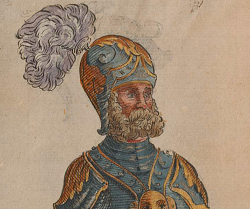|
|
You are not currently logged in. Are you accessing the unsecure (http) portal? Click here to switch to the secure portal. |
Wiktenauer:Main page/Featured
| Paulus Hector Mair | |
|---|---|
 "Mair", Cod.icon. 312b f 64r | |
| Born | 1517 Augsburg, Germany |
| Died | 10 Dec 1579 (age 62) Augsburg, Germany |
| Occupation |
|
| Influences | |
| Genres | |
| Language | |
| Notable work(s) | Opus Amplissimum de Arte Athletica |
| Manuscript(s) |
Codex 10825/10826 (1550s)
|
| Concordance by | Michael Chidester |
Paulus Hector Mair (1517 – 1579) was a 16th century German civil servant and fencing enthusiast. He was born in Augsburg in 1517 to a wealthy and influential family in the German middle class (Bürger). In his youth, he likely received training in fencing and grappling from the masters of Augsburg fencing guild, and early on developed a deep fascination with fencing manuals. He began his civil service as a secretary to the Augsburg City Council; by 1541, Mair was the Augsburg City Treasurer, and in 1545 he also took on the duty of Master of Rations.
Mair lead a lavish lifestyle and maintained his political influence with expensive parties and other entertainments for the burghers and city officials of Augsburg. Despite his personal wealth and ample income, Mair spent decades living far beyond his means and taking money from the Augsburg city coffers to cover his expenses. This embezzlement was not discovered until 1579, when a disgruntled assistant reported him to the Augsburg City Council and provoked an audit of his books. Mair was arrested and tried for his crimes, and hanged as a thief at the age of 62.
While Mair is not known to have ever certified as a fencing master, he was an avid collector of fencing manuals and other literature on military history, and some portion of his embezzlement was used to fund this hobby. Perhaps most significant of all of his acquisitions was the partially-completed manual of Antonius Rast, a Master of the Longsword and one-time captain of the Marxbrüder fencing guild. The venerable master died in 1549 without completing it, and Mair ultimately was able to produce the Reichsstadt "Schätze" Nr. 82 based on his notes. In sum, he purchased over a dozen fencing manuscripts over the course of his life, many of them from fellow collector Lienhart Sollinger (a Freifechter who lived in Augsburg for many years). After Mair's death, this collection was sold at auction as part of an attempt to recoup some of the funds Mair had appropriated.
Already in Mair's lifetime some of his people's Medieval martial arts were being forgotten; this was tragic to Mair, who viewed the arts of fencing as a civilizing and character-building influence on men. In order to preserve as much of the art as possible, Mair commissioned a massive fencing compendium titled Opus Amplissimum de Arte Athletica ("The Greatest Work on the Athletic Arts"), and in it he compiled all of the fencing lore that he could access. He retained famed Augsburg painter Jörg Breu the Younger to create the art for the text, and according to Hils Mair also hired two fencing masters to pose for the illustrations.[citation needed] This project was extraordinarily expensive and took at least four years to complete. Ultimately, three copies of the massive fencing manual—six volumes in all—were produced, the first entirely in Early New High German, another entirely in New Latin, and a third including both languages.
(Read more...)
